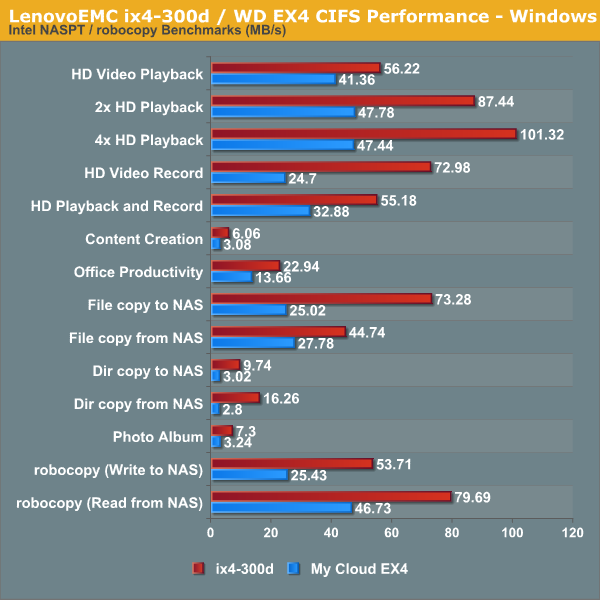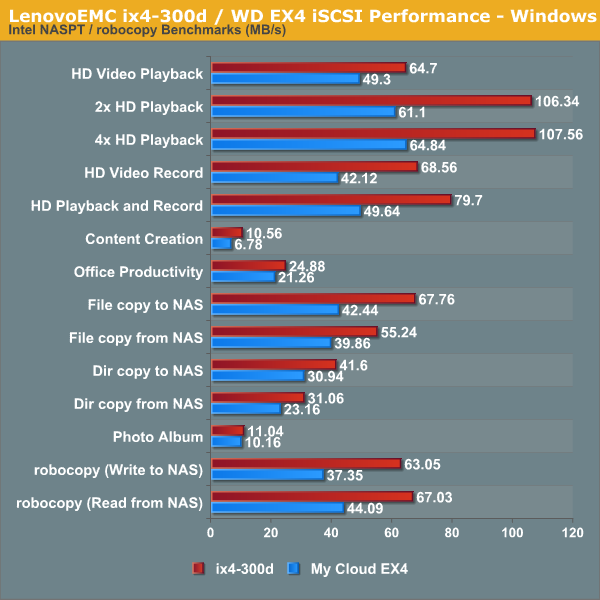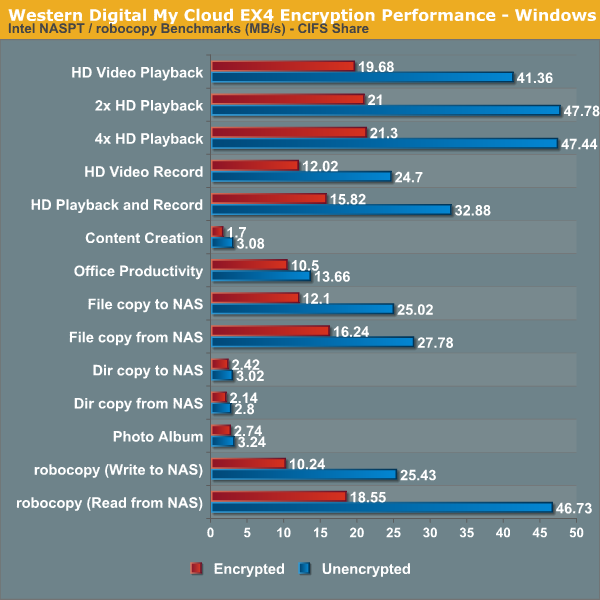Western Digital My Cloud EX4 and LenovoEMC ix4-300d Home NAS Units Review
by Ganesh T S on February 26, 2014 2:30 AM EST- Posted in
- NAS
- Western Digital
- LenovoEMC
Single Client Performance - CIFS and iSCSI on Windows
The single client CIFS performance of the LenovoEMC ix4-300d and WD EX4 were evaluated on the Windows platforms using Intel NASPT and our standard robocopy benchmark. This was run from one of the virtual machines in our NAS testbed. All data for the robocopy benchmark on the client side was put in a RAM disk (created using OSFMount) to ensure that the client's storage system shortcomings wouldn't affect the benchmark results. It must be noted that all the shares / iSCSI LUNs are created in a RAID-5 volume.

We created a 250 GB iSCSI target and mapped it on the Windows VM. The same benchmarks were run and the results are presented below.

Encryption Support Evaluation
Consumers looking for encryption capabilities can opt to encrypt a iSCSI share with TrueCrypt or some in-built encryption mechanism in the client OS. However, if requirements dictate that the data must be shared across multiple users / computers, relying on encryption in the NAS is the best way to move forward. Most NAS vendors use the industry-standard 256-bit AES encryption algorithm. One approach is to encrypt only a particular shared folder while the other approach is to encrypt the full volume. In our case, only the WD EX4 supports encryption, and only on a full-volume basis.
On the hardware side, encryption support can be in the form of specialized hardware blocks in the SoC (common in ARM / PowerPC based NAS units). In x86-based systems, accelerated encryption support is dependent on whether the AES-NI instruction is available on the host CPU (not considering units based on the Intel Berryville platform). The Kirkwood SoC used in the EX4 does have a security engine, so we the performance impact should not be brutal. We enabled encryption on a a CIFS share to repeat our Intel NASPT / robocopy benchmarks. The results are presented in the graph below (with the unencrypted folder numbers for comparison purposes).

The performance of the EX4 for normal volumes was barely acceptable. Unfortunately, enabling encryption only pulls down the numbers further, most times by more than 50%. We strongly urge users looking for good encryption support to look beyond the WD EX4 and LenovoEMC ix4-300d.










38 Comments
View All Comments
Icehawk - Thursday, February 27, 2014 - link
Raid 5? Why bother - the point of these cheap and slow devices IMO is for simple raid mirroring. I have an old WD 2 device job and it is slow as molasses but I don't really care as it is used as an archive dump to hold stuff I'd hate to lose.chizow - Thursday, February 27, 2014 - link
Accurate review from what I saw, I have the 2-bay version of the Lenovo/iomega NAS and the WD MyCloud EX4 as well. The hardware, mainly the single core CPU in the WD definitely hold it back especially with multi-client accesses, but I think the key feature that I did not see mentioned at all is the MyCloud's excellent cloud functionality. It also has a very easy to use smartphone app that allows you to access the NAS contents securely from anywhere with just a single sign-on username, no need for IPs or hostnames, port-forwarding, SSH or anything else that would scare off the average home user.The Iomega units are solid for their price, but they definitely aren't as fast as the Qnap or Synology units of the world, but the Iomegas can be had for a fraction of the price. Good entry-level home NAS units for those that have extra HDDs lying around and want to provide centralized network storage.
Frolictoo - Sunday, March 2, 2014 - link
I still can't believe that vendors use SATA II connectors when most new NAS drives come in the SATA III flavor. If legacy reasoning is the case then why not add both options; SATA III is backwards compatible with SATA II. I have just built a new NAS using all WD RED drives on a RAID 10 array and I am truly satisfied with the impressive performance gain over the older SATA II counterparts.M/2 - Sunday, March 2, 2014 - link
I've never understood consumer grade NAS drives. They're slow and problematic. Why not just set up a 4-bay RAID attached to a small computer and get RAID5 speeds over the network? I've got a 4-bay, USB3, RAID5 box (~$250 plus the cost of the drives) connected to a MacMini. Even on USB3, I get 250 Mb/s read/writes, Voila! 6X faster than NAS!Assuming you're using the Mini for other things than just network storage, the cost is about the same. There's also a dozen or so little MicroPC's with USB3 for ~$300-400 that you can do the same thing with if you're doing Windows. I love the MacMini because I can do everything I need over Remote Desktop, I never have to touch the Mini. You can put it in any dark corner and do everything remotely. Mine is in the very back of the entertainment center, it's just one more HDMI input on the AV receiver. If I need a big screen (iTunes, photos, movies) it's always there. Otherwise, it's there for remote clients including, laptops and AppleTV's. Try playing music or movies from a NAS drive! Yes you can do it, but it's not plug and play. This isn't intended to be an advert for Mac's, I just like my setup. You can do the same thing with a MicroPC.
What am I missing? Be nice, I'm not an IT guy.
chizow - Monday, March 3, 2014 - link
2 main reasons I can think of that prevented me from going this route:1) Power consumption: if you have something that you could repurpose for a NAS server, it's probably going to be old and power hungry. No way I would want one of my old X58 rigs powered 24/7 just to file server on my network. The WD MyCloud EX4 for example uses only ~15W idle and 30W under load. Huge difference.
2) Price: There are definitely low-power options available now, even something like a NUC connected over USB 3.0 wouldn't be a terrible option, or a mini-ITX box. But then you are talking real money, and that's before you take the drives into account.
Consumer-grade NAS boxes are often good enough, especially if you aren't asking a whole lot of them. I use mine to access shared DVRed shows from multiple PC clients wirelessly over the network as well as backing up data on my client machines, tablets, smartphones and it works well enough, provided I don't ask too much of it at once.
M/2 - Monday, March 3, 2014 - link
re: Power consumption... You got my curiosity going, a Mac Mini consumes 11W in idle mode (configured for wake on LAN). Mine has SSD's (RAID0 :) ), so it starts quick. I'm using a Dyconn Quartz4 which sleeps, there's no spec, but I'm assuming sleep mode must low, 4-5W? at most it's the same as a NAS.... so not much difference (at least to me)Re: NUC --- that's the cheaper option, except for one thing, it's Windows which is a pain in the *ss to manage ( for home use anyway, IMO, I made the switch about 5 yrs ago, never looked back) --- Regardless... I'm assuming the Mini is $0 added cost since I use it for other stuff besides network storage.
RAYBOYD44 - Monday, March 3, 2014 - link
John . even though Eleanor `s remark is super, last week I got BMW M3 after having made $6301 this last 5 weeks and over 10-k lass-month . this is certainly the best-work I have ever had . I actually started nine months/ago and straight away made myself over $70, p/h . svanel86 - Monday, March 3, 2014 - link
Since i owned a ix2-200d and a ix4-200d(free swap after my ix2 gave up and failed its own disks) i can attest you should run when offered the chance to get a lifeline -based device. If you activate the idle spin-off there is a very real chance the disk will be marked as dead by mdadm and since the disks die like flies in those due to the asthmatic fan(which spin on only if you get catastrophic temperatures) you are risking data daily if you use any powersaving option. The CIFS, NFS and AFS are very unoptimized, you can get unironically faster performance if you create a iscsi storage partition(which is the sole reediming feature of the former emc owned iomegas ixes, full vmware certification) and run a freenas within the storage area